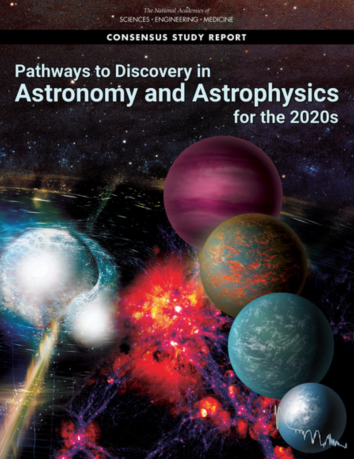Click the image to access the complete text of the ASTRO2020 report from the National Academy of Sciences.
National Academy of Sciences Report Ranks US Extremely Large Telescope Program, Including the Giant Magellan Telescope, as Top Priority for US Astronomy in the 2020s
8 November 2021
AUSTIN — A new report out from the National Academy of Sciences, the highly anticipated decadal survey Pathways to Discovery in Astronomy and Astrophysics for the 2020s, or “Astro2020,” has presented recommendations for making federal investments critical to achieving advances in US astronomy over the next decade. The report ranked the US Extremely Large Telescope Program (US-ELTP) as the top project for ground-based observatories, recommending federal support for the final construction stages of the Giant Magellan Telescope (GMT). The University of Texas at Austin is a founding partner in the international consortium to build the GMT.
“I am delighted that the astronomy and astrophysics decadal survey recommendations are aligned with the vision of McDonald Observatory and the UT Austin Department of Astronomy — that GMT will provide transformational observing capabilities to our faculty, students, and researchers,” said Taft Armandroff, Director of McDonald Observatory and Vice Chair of the GMT Organization Board. “We look forward to working with the National Science Foundation to realize the recommendations of Astro2020.”
Indeed, the report stated that building an extremely large telescope “is absolutely essential if the United States is to maintain a position as a leader in ground-based astronomy.”
“We are incredibly honored to be ranked as a top priority in the decadal survey and are grateful for the many scientists who engaged in the process,” said GMT Organization President Robert Shelton. “This endorsement solidifies the scientific momentum that our founding consortium of international universities and research institutions pioneered years ago. After all, we designed the Giant Magellan Telescope to discover the unknown, and it’s the unimaginable discoveries that could change humanity forever.”
The Giant Magellan Telescope was evaluated in Astro2020 as a core partner of the US-ELTP. The goal of the program is for the National Science Foundation’s NOIRLab to provide US-based astronomers with full-sky observing access to the Giant Magellan Telescope in the southern hemisphere and the Thirty Meter Telescope in the northern hemisphere. The US-ELTP was viewed by Astro2020 as a visionary program that will enable collaborative, inclusive, and transformational research in nearly all areas of astrophysics — from understanding the fundamental nature of the universe to the search for life on distant exoplanets.
“We are proud to be part of the US Extremely Large Telescope Program and its bold vision to provide full-sky access to the astronomical community,” said Walter Massey, GMT Organization Board Chair and former Director of the National Science Foundation. “A heartfelt congratulations to both the Thirty Meter Telescope and NOIRLab. This strong recommendation is the result of many years of hard work. It is a great time to support and join our inspirational project and help secure access to these amazing telescopes for decades to come.”
The 24.5-meter aperture GMT is positioned to put a federal investment to good use. Construction is well underway at Las Campanas Observatory at the southern edge of Chile’s Atacama Desert, one of the best locations on Earth to explore the heavens. The project has completed hard rock excavation for the foundation and support infrastructure, cast six of seven primary mirrors, begun fabricating its first adaptive secondary mirror, and has already secured a subaward from the National Science Foundation to accelerate the prototyping and testing of some of the most powerful optical and infrared technologies ever engineered.
Astro2020 highlights the GMT’s 368 square meter light-collecting power, unmatched 25-arcminute field of view, advanced adaptive optics system, and high-resolution spectroscopic and diffraction-limited imaging capabilities. The report emphasizes that the “capabilities can be brought to bear on nearly all of the important science questions laid out by this decadal survey, across all three of our key science themes.” These inspiring scientific priorities include pathways to habitable worlds, new windows on the dynamic universe, and drivers of galaxy growth. The recommendation also stated that the US-ELTP “provides observational capabilities unmatched in space or the ground and opens an enormous discovery space for new observations and discoveries not yet anticipated.”
The Giant Magellan Telescope is the work of an international consortium of leading universities and research institutions, including The University of Texas at Austin. To learn more, visit gmto.org.
— END —
Note to editors: The complete text of the decadal survey ASTRO2020 is available at: https://www.nap.edu/resource/26141/interactive/
Media Contact:
Rebecca Johnson
Communications Mgr., McDonald Observatory
The University of Texas at Austin
512-475-6763
Science Contact:
Dr. Taft Armandroff
Director, UT Austin McDonald Observatory
Vice Chair, GMT Organization Board of Directors
512-471-3300







